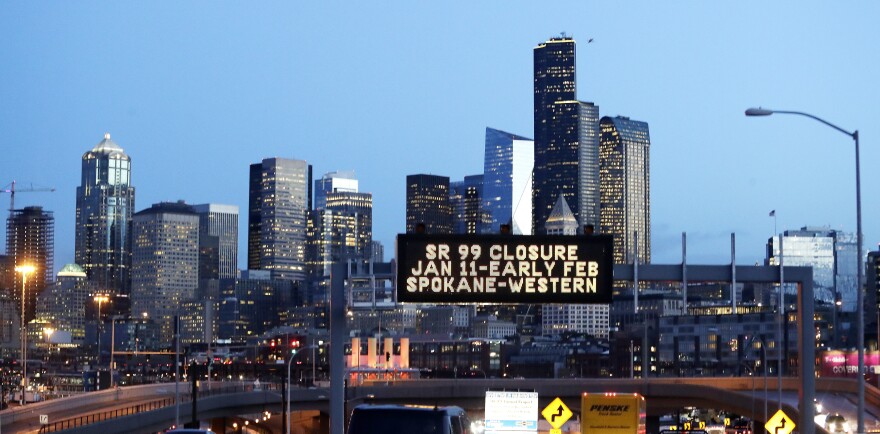Transportation officials have several recommendations to help commuters survive the three-week period between closure of the Alaskan Way Viaduct and opening of Seattle's new tunnel. Among them: work from home or flex your schedule.
Neither is an option for Charrie Gibson. The West Seattle resident teaches fourth grade at Cascadia Elementary School in North Seattle.
“Normally, I just take the West Seattle Bridge and hop on 99 and zip all the way up through Aurora and make a right on 90th and I’m here,” she said. “And in the mornings, I leave early enough that my commute’s about 25 minutes.”
For months, she’s been trying to figure out what to do during the viaduct closure. Her solution? Don’t even try to commute.
“I’ve been trying to look at different bus routes, taking the water taxi, doing the train, and I finally settled on — I’m going to take two days off a week and Wednesday, Thursday and Friday, I’m going to stay with a friend in Ballard,” Gibson said.
Doing that will require having a friend in West Seattle feed her cat. But she said the stress of trying to brave the streets to get to school on time was too much.
“I feel frustrated that there’s not a better system to get from West Seattle to North Seattle,” she said. Of course, in 2030, a light rail extension is supposed to open in West Seattle. “By the time I’m retired and don’t have to worry about it,” Gibson joked.
The closure of the viaduct will mean upheaval not just for the 90,000 drivers who use it every day. Removing that major north-south artery from Seattle’s transportation system will have ripple effects for commuters on other highways and surface streets, as well. The impending closure has triggered so much anxiety for Seattle-area commuters that some are calling it “Viadoom.”
The double-decker Alaskan Way Viaduct, which has been deemed seismically unsafe, will close for good at 10 p.m. today. The new state Route 99 tunnel is supposed to open in early February.
LESS SLEEP, LESS TIME WITH KIDS
For educators who are contracted to be at school at a certain time, this means shifting routines at home. Some said they’ll have to wake up earlier. Some said it means they won’t be as available to help students before and after school.
And this affects many people. About 6,900 Seattle Public Schools employees are based in schools as opposed to the district's central office. That includes teachers, librarians, counselors, principals and other school staff.
For Curtis Reed, a history teacher at Rainier Beach High School who lives in Seattle’s Wedgwood neighborhood, budgeting more time for his commute means spending less time with his 6-year-old son and two-month-old baby.
He said he plans to drive some of the time and take bus and light rail some of the time, but he’ll have to leave his house as much as 50 minutes earlier to get to school by 8:15 a.m.
“I had been taking my son to the bus stop every day and now I can’t do that,” Reed said. “My wife has to pull double duty and get the baby out of bed and get everybody going so I can be here at school on time.”
Merrick Bodmer, who lives in West Seattle, works part time as a librarian at Cascadia Elementary. She says she has no choice but to drive, because taking transit doesn't leave her enough time to pick up her kids after work. The viaduct closure is adding an hour to her commute — she plans to leave at 5:45 a.m. to get to school by 7:25.
“I’ve talked to lots of neighbors that are going to work from home or work from a different office other than the downtown office, but as a teacher we don’t really have that luxury to change our hours or change our location, so we’ll just see how it goes,” she said.
Sarah Thomas, a fourth-grade teacher at Mount View Elementary in White Center, said she already has little time to spare. She commutes with her husband, who's a high school teacher, from Seattle's Ravenna neighborhood; both are pursuing master's degrees.
"We already don't have a ton of time," she said, adding that sitting in traffic longer means less time for themselves or for homework.
She plans to listen to podcasts, including "This American Life" and "Radiolab," as a way to make the most of the drive. (Might we suggest Sound Effect?)
VIADUCT NOSTALGIA
Leticia Clausen lives in Ballard and teaches at Denny International Middle School in southwest Seattle. She plans to continue driving, but will use surface streets and the First Avenue South bridge to White Center, budgeting an extra 45 minutes.
Aside from the headache of a more difficult commute, Clausen is feeling nostalgic about losing the viaduct. She said she’s been trying to savor the drive these last few days.
“I’m going to miss the view because seeing Rainier in the morning, a spring morning, is just like, 'Wow,’” she said. “Not anymore.”
UPDATE, 10:40 a.m.: Adds the number of people who work in Seattle public school buildings.







